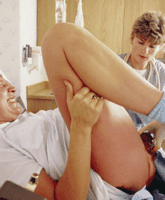This week in the BMJ
Volume 329,
Number 7462,
Issue of 14 Aug 2004
![[Down]](/icons/down.gif) Screening for vaginal infections halves preterm births
Screening for vaginal infections halves preterm births
![[Down]](/icons/down.gif) Perinatal death is more likely in women with previous caesareans if labour is induced with prostaglandin
Perinatal death is more likely in women with previous caesareans if labour is induced with prostaglandin
![[Down]](/icons/down.gif) Pelvic floor exercises make prolonged second stage of labour less likely
Pelvic floor exercises make prolonged second stage of labour less likely
![[Down]](/icons/down.gif) Perceived inequity in workload causes resentment in general practices
Perceived inequity in workload causes resentment in general practices
![[Down]](/icons/down.gif) Role of orbital radiotherapy in thyroid eye disease is controversial
Role of orbital radiotherapy in thyroid eye disease is controversial
![[Down]](/icons/down.gif) Many UN millennium goals are not on target
Many UN millennium goals are not on target
Screening for vaginal infections halves preterm births
Screening by Gram staining for a vaginal infection reduces preterm birth and late miscarriages. In a prospective randomised controlled trial by Kiss and colleagues (p 371), 4429 pregnant women underwent screening early in the second trimester for common vaginal infections. In the intervention group 3% of births were preterm, compared with 5.3% in the control group, a statistically significant reduction. Late miscarriages were also reduced: eight occurred in the intervention group and 15 in the control group.

| |
Credit: A CRUMP/TDR/SPL
|
|
![[To top]](/icons/back.gif)
Perinatal death is more likely in women with previous caesareans if labour is induced with prostaglandin
Induction of labour with prostaglandin is associated with an increased risk of uterine rupture, including catastrophic rupture leading to perinatal death. In a population based study involving about 36 000 women with a previous caesarean delivery, Smith and colleagues (p 375) found that women who had not previously given birth vaginally and those whose labour was induced with prostaglandin had a higher risk of uterine rupture when attempting vaginal birth—and if uterine rupture occurred, the risk of the infant dying is lower in obstetric units with higher throughput.

| |
Credit: CUSTOM MEDICAL STOCK/SPL
|
|
![[To top]](/icons/back.gif)
Pelvic floor exercises make prolonged second stage of labour less likely
Exercising pelvic floor muscles is associated with fewer cases of active pushing lasting over 60 minutes in the second stage of labour. Salvesen and colleagues (p 378) conducted a randomised controlled trial involving 148 nulliparous women who had a structured training programme for pelvic floor muscles and 153 who didn't. Training could prevent prolonged labour in one in eight women.

| |
Credit: MOOSE AZIM/BUBBLES
|
|
![[To top]](/icons/back.gif)
Perceived inequity in workload causes resentment in general practices
Perceived inequities produce tensions and resentment and place a burden on general practices. Branson and Armstrong (p 381) interviewed 18 general practitioners from 11 inner city practices in south London and found that equitable distribution of workload was a common concern in group practices. Ways of addressing the problem included relying on trust (in small practices) and creating systems based on explicit rules (in larger ones).

| |
Credit: JIM VARNEY/SPL
|
|
![[To top]](/icons/back.gif)
Role of orbital radiotherapy in thyroid eye disease is controversial
Reviewing recent developments in thyroid eye disease, Cawood and colleagues (p 385) say that numerous retrospective, uncontrolled studies led to the use of radiotherapy, but in recent prospective, placebo controlled trials it led to little or no improvement The authors identify smoking as the most important risk factor for developing thyroid eye disease and list the pitfalls in diagnosis, which include uniocular presentation. They emphasise the need for specialist management by a thyroidologist and an ophthalmologist.
![[To top]](/icons/back.gif)
Many UN millennium goals are not on target
Many countries are falling behind the millennium development goals set by the UN in 2000, say Haines and Cassels (p 394), and they are unlikely to be reached by 2015. For example, for mortality in children under 5 years, the developing world managed a reduction of only 2.5% in the average annual rate during the 1990s, well short of the target of 4.2%. Improved health outcomes will not be possible without major improvements in healthcare delivery systems, say the authors.

| |
Credit: DIETER TELEMANS/PANOS
|
|
![[To top]](/icons/back.gif)
Screening for vaginal infections halves preterm births
Perinatal death is more likely in women with previous caesareans if labour is induced with prostaglandin
Pelvic floor exercises make prolonged second stage of labour less likely
Perceived inequity in workload causes resentment in general practices
Role of orbital radiotherapy in thyroid eye disease is controversial
Many UN millennium goals are not on target





